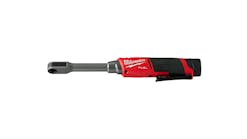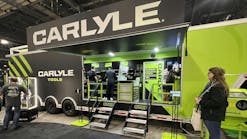It will soon be that time of the year when we will be breaking out our A/C machines regularly to service our client’s vehicles. There are so many variations on vehicles these days that when servicing A/C systems, you must consult your service information before working on a vehicle’s A/C System.
When working on hybrid or electrified vehicles, you will most likely be working with a three-phase alternating current A/C compressor that typically runs on several hundred volts. You will see your typical HV orange cabling running to the compressor to let you know you are working with a high-voltage system. Yes, those voltage levels are extremely dangerous, so make sure to follow manufacturer service directions.
Other concerns for the EVs include the correct compressor oil and even specific dye for the HV compressors (Figure 1). If either the wrong oil or dye is used, the cars can set HV circuit isolation faults, shutting the A/C system down. We use Tracer Products Fluoro-Lite because it meets manufacturer specifications for the HV system requirements (having high dielectric properties). If the wrong oil is used, most of the manufacturers do not have a recommended service procedure to correct for contamination other than replacing all the system’s components. Keep in mind, for vehicles that the compressor is driven directly (without a clutch), you cannot run those vehicles without a refrigerant charge. You risk internally damaging the compressor.
When working on a modern A/C system, you must have a professional-grade scanner to look at the HVAC system information. You may have access to system pressures, temperatures, flow valves, and much more. In fact, the modern A/C systems on many Chrysler vehicles can take all the system data and self-diagnose.
You will also need the scanner to have bidirectional controls to operate system components (such as the flow valves, actuators, and clutches). One thing to remember is that the air conditioning system really is conditioning the air (removing heat and moisture). An example of this would be a vehicle in that the A/C system is working normally, but the air coming out of the vents is 90 degrees F. Remember that in the HVAC box, all of the air goes through the evaporator first, but the air is redirected through the heater core if warmer cabin temperatures are desired. If you have a malfunctioning temperature door or actuator, it is possible to have 90 degrees F coming out of the vent, with colder cabin temperatures desired. Even with a properly operating A/C system refrigerant loop, since the air is not being directed away from the heater core, it will be heated.
Refrigerant oils
We started with mineral oil as a lubricant in the R-12 systems, and it worked well, but the problem arose when those systems were converted to R-134a. The R-134a refrigerant would not carry the mineral oil molecules and, therefore, could not lubricate the compressor.
When doing R-134a retrofits, the systems were to be flushed and then filled with either Polyalkkylene Glycol (PAG), or ester oil, both being synthetic oils. The problem with both PAG and ester oil is that they are both hygroscopic, meaning they will absorb water. If this occurs, the mixture will create hydrofluoric acid and damage the internal components of the A/C system.
Also, keep in mind that it is important to use the correct weight of PAG oil. There are three different weights typically used in the automotive industry (46, 100, and 150). Where 46 and 100 are the most common, in the 1990s and early 2000s, GM did use 150. PAG oil is also used with R-1234yf refrigerant. Use your repair information to research the correct oil (and amount) along with the correct refrigerant charge for the vehicle that you are working on. You can see the required specifications from Mitchell1 ProDemand for a 2009 Toyota Prius (Figure 2). Remember that when replacing A/C components, they should be drained of all oil and the collected oil should be measured to ensure the correct amount of oil is put back into the system. Both too little and too much oil can potentially damage the compressor.
We’ve had a Robinair 34788 R-134a machine for 15 years (Figure 3). It has serviced hundreds of vehicles throughout its service life. We have been religious about machine maintenance by changing the compressor oil and the internal filter. However, we did run into a problem with the internal solenoid valves sticking. Due to servicing a vehicle that had stop-leak (a system sealing fluid) installed in the A/C system (that we were not aware of until after the fact), the machine was damaged. We typically avoid servicing those vehicles if we know the customer has used a stop-leak type product.
There is one drawback to this A/C machine; it cannot flush the A/C lines. As a result of this, we do not use this machine to charge hybrid vehicles. We use Technics Eco Dual Gas A/C machine for that (Figure 4). Before purchasing that machine, we would use Snap-on tools ACTR4151A refrigerant gauges (Figure5), a Matco Tools AC98210A refrigerant scale (Figure6), and a virgin tank of R-134a to charge the hybrid A/C systems. This ensured that we did not contaminate the A/C Systems. For the R-1234yf systems, we purchased a Robinair AC1234-6 A/C Machine, which has a built-in flushing feature to ensure that contamination does not happen (Figure 7).
There are many options for A/C machines on the market. Do your homework to see which one is right for you. I prefer separate machines for each refrigerant. In the event the machine breaks, you are not shut down on both refrigerants. However, if space is a concern, a dual machine can be quite convenient.
Diagnostics
When it comes to diagnosing A/C system performance, most technicians will look at the system pressures and the vent duct temperature. I strongly suggest starting with a full vehicle scan of the car. Remember that when you push the A/C button, you are not turning on the A/C directly. You are asking the vehicle to turn on the air conditioning. There may be other faults in the vehicle that are keeping the vehicle from operating the A/C system.
A complete visual inspection should be made under the hood. Look for anything that is out of the ordinary. Check your engine fan for proper operation and that there are no restrictions to the airflow through the condenser. I have run across vehicles that had accumulated quite a bit of debris between the radiator and condenser. This condition created a poor performance symptom of the A/C system and higher than normal system pressures (as the refrigerant wasn't being cooled enough).
The most effective way to properly diagnose the operation of the system is to take temperature measurements at multiple points through the A/C system’s refrigerant loop. The measurements will be taken at the inlet and outlet ports of the A/C components. This can then be considered to determine the actual cause of the failure. The main concept of temperature measurement comes from the fact that refrigerant temperatures directly correspond to their pressure. By taking these measurements, you can see the specific pressure in the system at each location and not just at the service ports.
Remember, the key to the air conditioning system is the evaporation and condensing of the refrigerant. The air conditioning isn't blowing cold air. It absorbs the heat energy from the cabin air and transfers it to the condenser, where the refrigerant then transfers the heat to the atmosphere.
To learn more about temperature testing of the A/C system, Jim Cokonis, an instructor and curriculum developer for Carquest Technical Institute, wrote a great article on enthalpy charts. (The article can be found on the Vehicle Service Pros website, vehicleservicepros.com/21220569). Enthalpy charts detail the performance of the refrigerant as it moves through the refrigerant system. Learning to use an enthalpy chart will lead you to the fastest and most accurate way of diagnosing a system failure.
In closing, if you experience a compressor failure and debris has traveled through the entire system, not only must you replace the receiver/dryer or accumulator, but you should plan on replacing the condenser. Today’s condensers have much smaller tubes for better heat transfer. As a result of the smaller tube size, it is nearly impossible to flush out the debris entirely from the condenser as it will become stuck in the tubes.
The evaporator should be replaced as well for the same reason, but in many vehicles, it is not practical for the required time. Make sure to thoroughly flush the evaporator and the rest of the A/C system. If enough of that debris stays in the system, you will ultimately damage the new compressor.
Many of our suppliers have begun selling A/C kits that will include most of the parts needed to repair the A/C system properly after a major failure. Don't forget to replace the orifice tube as well when dealing with a compressor failure. A good A/C job will also include the replacement of the receiver/dryer or accumulator anytime the system has been opened to the air. There are desiccant bags that will absorb moisture while the system is open and will negatively affect system performance if not replaced.
Like anything else, performing a proper A/C system repair requires patience and a thorough approach. Taking shortcuts and skipping out on some of the suggested items above can ultimately lead to a comeback, more damaged components, and very dissatisfied customers.
Tools Used
- Tracer Products UV dye
- Technic Dual Eco A/C machine
- Snap-on pressure gauges
- Matco Tools refrigerant scale
- Robinair YF1234 A/C Machine


